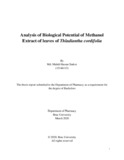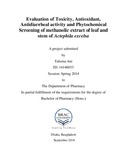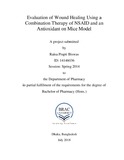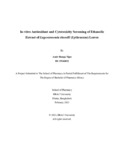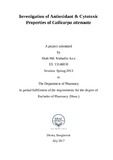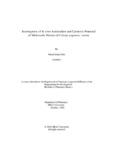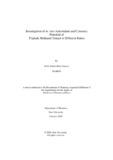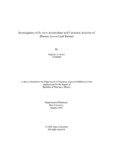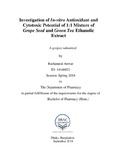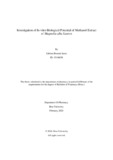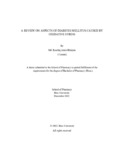Browsing by Subject "Antioxidant"
Now showing items 1-20 of 27
-
Analysis of biological potential of methanol extract of leaves of thladiantha cordifolia
(Brac University, 2020-03)The thesis which includes 4 different experimental processes, was performed to evaluate and determine the biological potential of Thladiantha cordifolia which is a medicinal plant which is from cucurbitaceae family. ... -
Anti-alzheimer and antioxidant activity of celastrus paniculatus seed
(© 2011 Iranian Journal of Pharmaceutical Sciences, 2011)The crude methanolic extract of the seeds ofCelastrus paniculatus along with its organic soluble fractions were tested for their possible antioxidant and antialzheirmer (AD) activity. The extracts showed prominent DPPH ... -
Antibacterial and antioxidant properties of Crateva magna bark crude extract
(Brac University, 2023-06)Chemical compounds derived from plants have been used to treat several diseases all over the world since the dawn of human civilization. Many of the drugs that are currently on the market have either been directly or ... -
Antioxidant and hypoglycemic effect of Flacourtia jangomas
(Brac University, 2019)Flacourtia jangomas known as lukluki fruits is assuming to have antioxidant and hypoglycemic profile. In order to prove that, we have chosen the methanolic extract of Flacourtia jangomas fruits for assessing the antioxidant ... -
Antioxidant, analgesic and CNS depressant effects of Synedrella nodiflora
(© 2012 Elsevier Ltd., 2016-10)Synedrella nodiflora (L) Gaertn. belonging to the family Asteraceae contains steroids, reducing sugars, phenolic, flavonoids, saponins, tannins and triterpenoids. Therefore, this study is designed to investigate its ... -
Effects of Allium sativum extract in arsenic induced toxicity in Swiss albino mice
(Brac University, 2019-08)Arsenic (As) is metal toxic element to the body and it is available in environment. Arsenicosis, elevated level of As in body, can be treated by chelation therapy. In chelation therapy, a chelate is used to form a complex ... -
Evaluation of toxicity, antioxidant, antidiarrheal activity and phytochemical Screening of methanolic extract of leaf and stem of actephila excelsa
(BRAC University, 2018-09)For a long time, human is seeking thoroughly for natural medicines to treat different types of diseases. Disregarding the expansion of synthetic drugs to treat incessant disease, the exploitation of natural medicines keeps ... -
Evaluation of wound healing using a combination therapy of NSAID and an antioxidant on mice model
(BRAC University, 2018-07)Skin is the first line of defence mechanism in our body. When the protective barrier of skin breaks we can define it as a wound. Wounds need to be healed very fast in order to restore body’s normal defence mechanism. For ... -
In vitro biological screening of ethanol extract of Pterocarpus Indicus Willd. (Fabaceae) leaves
(Brac University, 2023-02)This research was carried out to assess the biological properties of the Pterocarpus Indicus Willd. leaves of the Fabaceae family. To study the leaves, antioxidant activity was examined using DPPH free radical scavenging ... -
In-vitro antioxidant and cytotoxicity screening of ethanolic extract of lagerstroemia thorelli (Lythraceae) leaves
(Brac University, 2023-02)"Substantial antioxidant activity of Lagerstroemia thorelli leaves extract was revealed in DPPH free radical scavenging assay with an IC50 value of 83.05085 μg/mL compared to that of 47.55245 μg/mL demonstrated by ascorbic ... -
An in-vitro study on antioxidant properties of Alcea rosea leaves
(Brac University, 2020-02)The aim of the study is to determine free radical scavenging capacity, total phenolic content and total flavonoid content and to investigate the in-vitro antioxidant potential of methanolic leaves extract of Alcea rosea. ... -
Investigation of antioxidant & cytotoxic properties of callicarpa attenuata
(BRAC University, 2017-07-06)Present study was performed to find out important phytochemical constituents, and establish the scientific basis of the use of the leaves of Callicarpa attenuata as therapeutic agent in traditional medicine in Bangladesh. ... -
Investigation of in vitro antioxidant and Cytotoxic potential of Methanolic extract of celosia Argentea leaves
(Brac University, 2020-10) -
Investigation of in vitro antioxidant and cytotoxic potential of Triphala methanol extract in different ratios
(Brac University, 2020-02)Triphala is comprised of Bibhitaki Amalaki and Haritaki and its methanol extract was chosen for the In vitro antioxidant and cytotoxic potential studies. Firstly, in the DPPH test the IC50 value was found to be 15.93 μg/ ... -
Investigation of in vitro antioxidant and cytotoxic properties of Lagerstroemia thorelli leaf extract
(Brac University, 2023-09)Lagerstroemia thorelli belongs to the Lythraceae family and is natively known as choto jarul. This study was undertaken to identify the antioxidant and cytotoxic properties of this plant since no previous reports on its ... -
Investigation of in-vitro antioxidant and cytotoxic activity of Blumea lacera leaf extract
(Brac University, 2019-10)Blumea lacera (family: Asteraceae) is a very potent plant for its various therapeutic properties. This research was intended to detect the antioxidant and cytotoxic potential of chloroform extract of this plant leaf. ... -
Investigation of in-vitro antioxidant and cytotoxic potential of 1:1 mixture of grape seed and green tea ethanolic extract
(BRAC University, 2018-09)Grape seed extract and Green tea (also known as Camellia sinensis) are two very common plants extracts that have been generally used in several food and beverage applications. Due to the health benefits associated with ... -
Investigation of in-vitro biological potential of Methanol extract of Magnolia alba Leaves
(Brac University, 2020-02)From immemorial time medicinal plants are used as an important source of medication for ailments and diseases. Now a day it has expanded the source of income also. In this experiment some pharmacological activities were ... -
Pharmacological and nutritional importance of Mushrooms
(Brac University, 2021-01)Mushrooms are micro fungi cultivated and consumed by peoples of different countries across the world. Even though they are quite common, but their significant importance is not that much known to everyone. Mushrooms have ... -
A review on aspects of diabetes mellitus caused by oxidative stress
(Brac University, 2022-12)As a result of constant exposure to various stimuli, the human body produces reactive species known as free radicals (ROS/RNS), which oxidize cellular components through the transfer of their free unpaired electrons. ...

